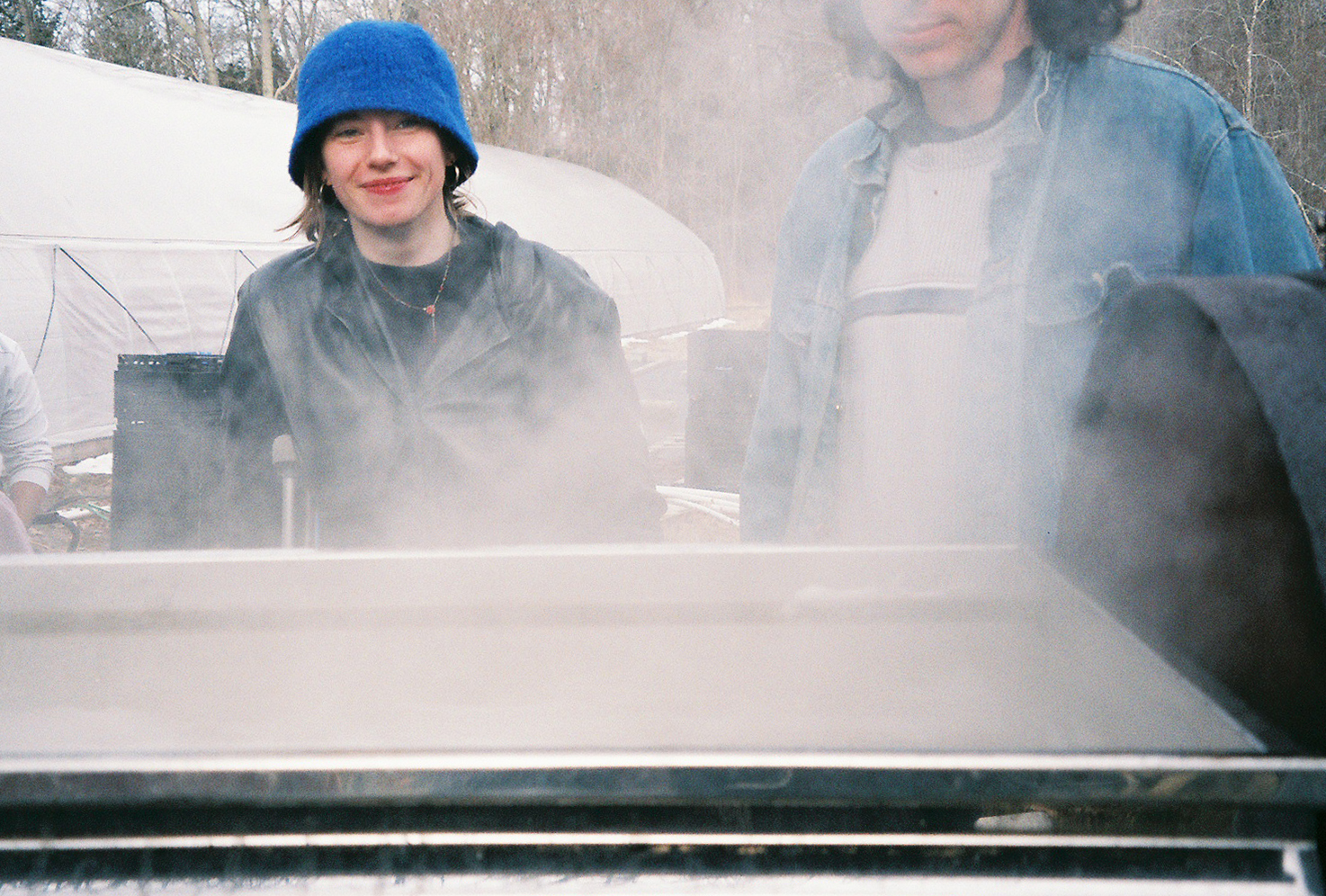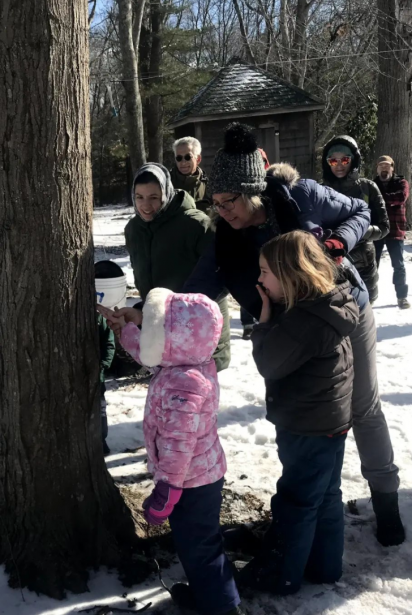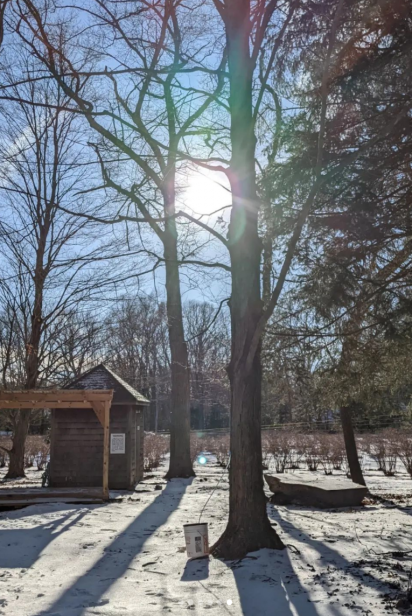Maple Tapping: Making Syrup on the Farm or at Home
In early February I made a visit to Osamequin Farm in Seekonk, Massachusetts, with a few of my maple-enthusiast friends for a tapping demo. We were there to kick off Osamequin’s first community maple season. Since it was soon after a large snowfall, we stepped carefully, though sometimes playing games by sliding on the icy paths as we toured the farm’s maple taps and boiling system. It was a sunny day and Farm Director Sarah Turkus instructed us on the proper method to tap a tree and collect the crystal-clear sap.
Sap flows from trees when the days are above freezing and nights are below freezing. In Rhode Island, this typically occurs in February and March. Maple syrup is typically made by tapping sugar maples, because their sap has a high sugar content, though sap from other maple species and many other trees can be collected to make syrup. Birch trees are also a popular choice for sap collection.
To identify good trees for tapping, you can use several online guides, such as this video. Trees that are good for tapping are not only found in forests; urban tree tapping can be equally successful. Trees for tapping need to be at least 10 inches in diameter and appear to be in good health. This season, I collected sap from a Norway maple and a sugar maple in my neighborhood in Providence.
Once the tree is selected, choose a spot that is anywhere from three feet to chest height off the ground, preferably on the south-facing side of the tree. While it might seem like a perfect place for a hole, don’t tap inside a fold or seam where it looks like the tree might have healed from a wound. Instead, look for a relatively smooth surface on the tree to place your tap.
To tap a tree, you will need a bucket and some kind of covering, as well as a drill, rubber mallet and spout, or spile (this is the piece that is tapped into the tree). The simplest spiles can be made out of a piece of small metal tubing, or you can purchase your own kit. Using a drill bit that fits the size of your spile, drill into the tree at a slight upward angle so the power of gravity is on your side. As you drill, light shavings should come out of the tap hole, indication that the tree is healthy.
With the mallet, carefully “tap” your spile into the hole. Soon enough, you will see clear sap dripping! Either attach the bucket so sap will drip from the spile directly into it, or attach plastic tubing so gravity can pull sap from numerous taps to a central location. If you can, cover your buckets well to prevent leaves or dirt from blowing into the sap. Sometimes even small animals get curious about the sweet liquid.
After waiting patiently for enough sap to collect in the buckets, you are ready to begin boiling it down into syrup. This might happen faster than you think: On warm days, my bucket was overflowing by mid-afternoon.
I returned to Osamequin Farm in early March for their community maple boil, bringing along a few gallons of sap I had collected. This time, there was no ice underfoot, but mud. The ground had been softened by recent warm days and the sun was shining down.
The furnace for boiling the sap was fired up and great wafts of steam were floating into the air. The boiling sap had been collected within the previous few days. To be safe, sap should always be boiled or used within about one week of collection, and just like other fresh food products, it can spoil, so it should be stored in a cool place. Once you collect enough sap (about five gallons boils down to one cup), the best method to reduce it to syrup is to boil it over an open fire, outdoors. Boil the syrup until it turns amber and reaches about 219°F—approximately 7° above boiling temperature.
During the community boil at Osamequin, we were able to taste the sap at different points in the boiling process. Each time the sap became darker and thicker, we were wowed by its growing sweetness. Before we sampled the sap Tracey Dancing Star of the Pokanoket tribe told us the story of the sugaring tradition and the maple moon: A long time ago, the maple trees used to ooze with syrup year-round, and the people of the village could be found lying under the maple trees drinking syrup all day. The Great Teacher saw that they were not working and tending to the earth, and so took buckets of water from the lakes and rivers and poured them into the trees. The sap then became diluted and only slightly sweet, to serve as a reminder of our responsibilities to the earth. That’s why today it takes about 40 gallons of maple sap to make 1 gallon of maple syrup.
Though making maple syrup is a lengthy process, there is much to enjoy about the whole experience. Pouring partially boiled sap over shaved ice to make maple snow cones is just one. Or try boiling down maple syrup even more, then pouring it over hard-packed snow so it hardens into sticky taffy. You can also use maple syrup in cocktail recipes, or just drink the strained sap as is (before boiling) for a mildly sweet glass of water.
As you make plans to harvest sap and make your own syrup during next winter’s sap flow, check out these local maple producers for Rhode Island–made maple syrup:
Charlie’s Sugar House
401.826.4873
www.rimaplesyrup.com
Charlie’s Sugar House is one of the largest maple producers in Rhode Island—their syrup is sold in stores across the state!
Chepachet Farms
226 Tourtellot Hill Rd.
Chepachet, RI
www.chepachetfarms.com
From late February through mid-March, Chepachet Farms places several hundred taps in trees and uses the gallons of sap collected to make products such as their Maple Vinaigrette Dressing and Cinnamon-Infused Maple Syrup.
Leach Farm and Orchard
147 Austin Ave.
Greenville, RI
401.862.5156
Leach Farm and Orchard harvests sap and bottles syrup during maple season, but sells during the picking season in the fall. Call ahead in the late winter for a maple-tapping demonstration by appointment.
Maple Valley Farms
1876 Frenchtown Rd.
East Greenwich, RI
401.680.3724
www.facebook.com/Maple-Valley-Farms-259965111178155/
Find Maple Valley Farms’ farm-fresh eggs and homemade maple syrup made right at the farm at Goddard Park and Blackbird Farm farmers markets.
Osamequin Farm
80 Walnut St.
Seekonk, MA
774.901.4725
OsamequinFarm.org
www.osamequinfarm.org
Osamequin Farm just hosted its first community tapping season, with community demos and boils each weekend. Look for it again next year!
Pippin Orchard
751 Pippin Orchard Rd.
Cranston, RI
401.943.7096
PippinOrchard.com
www.pippinorchard.com
In addition to their homemade maple syrup, Pippin Orchard makes apple syrup by boiling down apple juice into a sticky treat.
Spring Hill Sugar House
522 Gardner Rd.
Richmond RI
401.788.7431
www.facebook.com/Spring-Hill-Sugar-House-130250857046253/
Founded in 1980, this farm is open weekends in March for maple syrup demonstrations… though if you can’t make it out this month, maple syrup is still for sale year-round!







